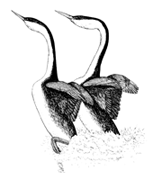Papers in the Biological Sciences
Date of this Version
April 1987
Abstract
Grebes are small to medium-sized diving birds having bills that vary from short and rather blunt tipped to long and acutely pointed, with bare lores and head feathers not extending to the linear or oval nostrils. There are 11 functional primaries and 17–22 secondaries, the inner secondaries longer than the primaries. Molting of the primaries is simultaneous; the wings are not used for underwater propulsion, which is provided by the feet. The rectrices are soft, rudimentary, and hidden. The body feathers are small, water-resistant, and shiny. Aftershafts and adult down feathers are present. The legs are set extremely far back on the body, making walking difficult and takeoff from land impossible. The tarsus is laterally compressed, with a scutellated scale pattern, and is serrated behind. The hallux is long and elevated; it and the front toes are separately lobed, and the claws are flat and nail-like. The wings are somewhat rounded to rather elongated, and most species have a white patch or "speculum" on the secondaries. The body is short, with a variably long neck and silvery white plumage on the underparts. Facial tufts or crests are usually present in both sexes during the breeding season. All species are monogamous and lack apparent sexual dimorphism; most have distinct breeding and wintering plumages. Their nests are built of floating and emergent vegetation anchored in shallow water. The eggs (3 to 9) are unspotted whitish and are elliptical to nearly fusiform. The young are covered with dense down and typically have complex color patterning. As with loons, the young have extended fledging periods and often are carried about on their parents' backs. The family has a nearly cosmopolitan distribution, and the species are mostly migratory, usually wintering on salt water and breeding colonially or solitarily in shallow and reedy freshwater habitats. Their foods include fish, aquatic invertebrates, and some plant materials; for uncertain reasons feathers are also often swallowed. There are at least twenty species, six (or seven) of which breed in part or entirely in North America, mainly in temperate-latitude marshes.
Least Grebe
Pied-billed Grebe
Horned Grebe
Red-necked Grebe
Eared Grebe
Western Grebe


Comments
From Diving Birds of North America (1987) by Paul A. Johnsgard. Copyright © 2007 Paul Johnsgard. Cite this work as: Paul Johnsgard, Diving Birds of North America (Lincoln, Nebraska: University of Nebraska Press, 1987; University of Nebraska–Lincoln Libraries, 2008 [ebook edition]).